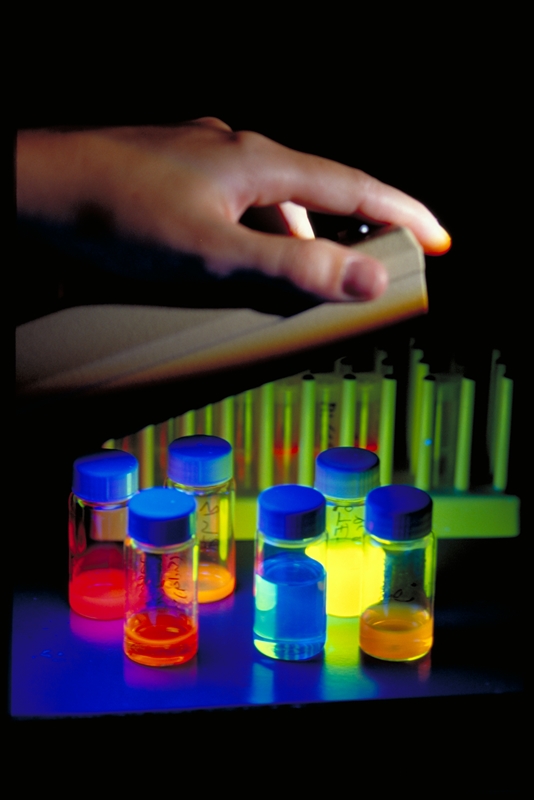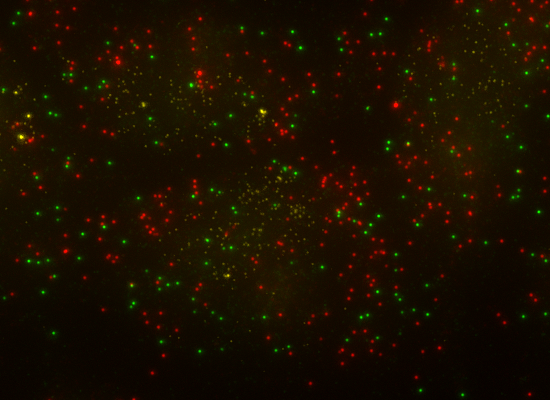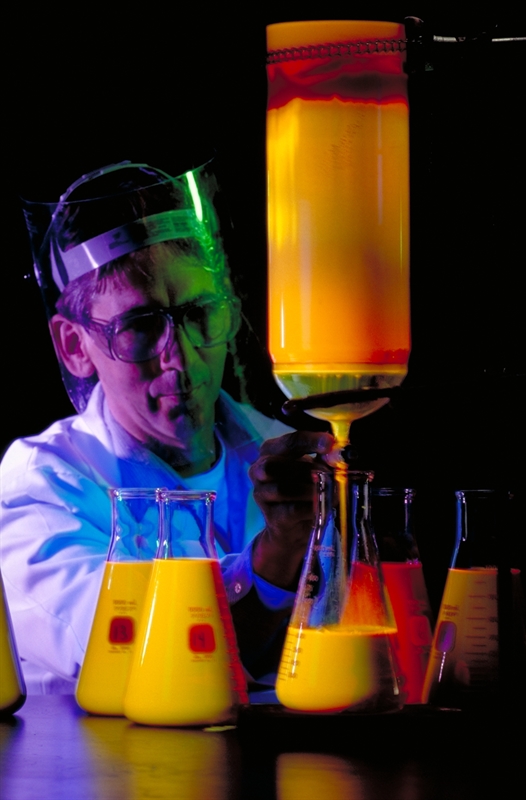Stellaris dyes and modifications
Find details about all the dyes and modifications currently offered for Stellaris RNA FISH Probe sets. Multiplexing recommendations, dye stability testing, emission and absorption spectra, use notes, publication links, and much more are here to help you choose the optimal modifications for your experiment.
Here, you will find everything you need to know to choose the optimal fluorescent dye or other modification for your Stellaris RNA FISH probe set(s). The most critical step to choosing a dye is checking compatibility between your filter set(s) and the dye that you wish to use. Even the best dye is useless for RNA FISH if you can’t see it with your current microscope setup. Visit Chroma's spectra-viewer to view plots of our dyes in any combination to help plan multiplexing experiments. Other filter manufacturers besides Chroma may be compatible with our fluorophores. Please refer to your filter's specification sheet for compatibility.
| Modification | Alternative dyes | Ex (nm)/ Em (nm) |
Percentage of all publications Click to visit publications |
|
|---|---|---|---|---|
Fluorophores |
||||
| FAM (Fluorescein)* | FITC | 495/520 | 5% | |
| CAL Fluor® Orange 560 | mKO/mOrange | 538/559 | <1% | |
| Quasar® 570 | Cy3 | 548/566 | 25% | |
| TAMRA | TRITC | 557/583 | 7% | |
| CAL Fluor Red 590 | TAMRA | 569/591 | 7% | |
| CAL Fluor Red 610 | mCherry/TEXAS RED | 590/610 | 10% | |
| CAL Fluor Red 635 | 618/637 | <1% | ||
| Quasar 670 | Cy5 | 647/670 | 27% | |
| Biotin | n/a | 0% |
* Please note that due to variable auto-fluorescence in the green channel inherent to cells and tissue, we do not recommend use of the FAM for some Stellaris RNA FISH applications. We recommend testing your sample for green channel autofluorescence before ordering FAM labeled sets or ordering an alternative dye that is compatible with your experiment.


Human A549 cells probed with TOP1 with Quasar 670 (red), TFRC with Quasar 570 (green), and TERC with CAL Fluor Red 610 (yellow)
Fluorophores manufactured by Biosearch Technologies
Since the early 80s, innovators at Biosearch Technologies have continued to refine the chemistry of oligonucleotide synthesis, including development of our proprietary CAL Fluor and Quasar fluorophores. We are completely vertically integrated, which means that every step of research, development, chemistry, and manufacture of our proprietary fluorophores and oligos occur in our Petaluma facility, north of San Francisco, CA. No aspect of dye or oligo production is outsourced, allowing us to tightly manage quality and offer unprecedented flexibility to meet custom requests.

General Description: The Fluorescein modification incorporates a fluorescein (FAM) moiety at the terminus of an oligonucleotide. FAM fluoresces in the green region of the visible spectrum.
Special Notes and Considerations: The green channel where FAM fluoresces is not ideal for RNA FISH as there tends to be high auto-fluorescence from the specimen itself. This auto-fluorescence can make it difficult to discern true RNA transcripts from background, and is especially true in tissue where auto-fluorescence is generally already higher. Because of this, probe labeled with FAM perform best in cultured cells. Additionally we recommend the use of FAM-labeled probe sets with >35 individual probes, and as a compliment to a primary probe set. Usage should be limited to specimens with known low autofluorescence, fixed with MeOH/HAC, and when other filter options are not available.
Anti-fade Recommendations: The FAM dye requires an anti-fade mounting media and is compatible with Vectashield by Vector Labs (H-1000) and Prolong Diamond by ThermoFisher (P36961). Please note that FAM is incompatible with enzymatic glucose-oxidase/catalase (GLOX) antifade.
How long will my sample last after mounting?: The FAM signal should be imaged immediately. Hardmount Prolong Diamond will allow for spot verification up to 5 days, but with greatly reduced signal to noise ratio after the first day.
Filter Recommendation: Our in-house team uses Chroma's 49011-ET-FITC/Alexa Fluor 488/Fluo3/Oregon Green single band filter set.
Absorption and Emission Spectra for FAM Dye
Properties:
- Name: Fluorescein
- Formula: C24H18NO8
- Absorption maximum (lambda max): 495 nm
- Extinction coefficient at lambda max: 71,300 M-1cm-1
- Extinction coefficient at 260 nm: 26,900 M-1cm-1
- Fluorescence maximum: 520 nm
What have other scientists done with this dye?
General Description: The CAL Fluor Orange 560 modification adds a fluorescent CAL Fluor Orange 560 dye to the end of an oligonucleotide. CAL Fluor Orange 560 fluoresces in the orange region of the visible spectrum. It is used as a replacement for the VIC, HEX and JOE dyes.
Special Notes and Considerations: The CAL Fluor Orange 560 dye is not commonly used for Stellaris RNA FISH probes, though it is a viable option and has been successfully used and published. As a result, we have limited experience with the particular characteristics of this dye when attached to RNA FISH probe sets.
Anti-fade Recommendations: We generally recommend Vectashield by Vector Labs (H-1000) and Prolong® Diamond Anti-fade Mountant by ThermoFisher Scientific (P36961) for all of our dyes, but no compatibility tests have been performed with this dye.
How long will my sample last after mounting?: No longevity studies have been performed on this dye. We recommend imaging immediately after mounting.
Absorption and Emission Spectra for CAL Fluor Orange 560 Dye
Properties:
- Name: CAL Fluor Orange 560
- Formula: C39H50N5O7
- Absorption maximum (lambda max): 538 nm
- Extinction coefficient at lambda max: 87,800 M-1cm-1
- Extinction coefficient at 260 nm: 18,800 M-1cm-1
- Fluorescence maximum: 559 nm
What have other scientists done with this dye?
General Description: The Quasar 570 modification incorporates a fluorescent Quasar 570 dye at the terminus of an oligonucleotide. Quasar 570 fluorophore is an indocarbocyanine dye which fluoresces in the yellow-orange region of the visible spectrum. It is used as a direct replacement for the Cy3 dye.
Special Notes and Considerations: This is a very stable and bright dye that is ideal for probe sets with smaller numbers of probes (less than 30) or for use in tissue as auto-fluorescence tend to decrease with longer wavelengths.
Anti-fade Recommendations: The Quasar 570 dye performs best with an anti-fade mounting media and is compatible with Vectashield by Vector Labs (H-1000), Prolong Diamond by ThermoFisher (P36961), Prolong Gold by ThermoFisher (P36930), and Slow Fade Diamond by ThermoFisher (S36963).
How long will my sample last after mounting?: When stored at +2 to +8 °C in the dark, the Quasar 570 signal remains stable for up to a week in the anti-fades listed above. Hardmount anti-fades such as the Prolong products and Vectashield soft set may extend the life of your sample for months past mounting.
Filter Recommendation: Our in-house team uses Chroma's SP102v1-Cy3™ v1 single band filter set. Chroma's 49304-ET-Gold FISH single band filter also fits Quasar 570 well.
Absorption and Emission Spectra for Quasar 570 Dye
Properties:
- Name: Quasar 570
- Formula: C34H45N3O3
- Absorption maximum (lambda max): 548 nm
- Extinction coefficient at lambda max: 115,000 M-1cm-1
- Extinction coefficient at 260 nm: 9,000 M-1cm-1
- Fluorescence maximum: 566 nm
What have other scientists done with this dye?
General Description: The TAMRA modification incorporates a fluorescent tetramethylrhodamine (TAMRA) at the terminus of an oligonucleotide. TAMRA is a rhodamine dye that fluoresces in yellow-orange region of the visible spectrum.
Special Notes and Considerations: TAMRA is a suitable dye for Stellaris RNA FISH assays as it is both bright and stable. As with the Quasar 570 and CAL Fluor 610 dyes, this is a suitable option if you have a probe set with a low number of probes (35 or less). This dye works well in both cells and in tissue, though a far red dye can be a better choice in highly auto-fluorescent tissues such as brain or prostate.
Anti-fade Recommendations: We generally recommend Vectashield by Vector Labs (H-1000) and Prolong Diamond by ThermoFisher (P36961) for all of our dyes, but no compatibility tests have been performed with this dye.
How long will my sample last after mounting?: No longevity studies have been performed on this dye. We recommend imaging immediately after mounting.
Absorption and Emission Spectra for TAMRA Dye
Properties:
- Name: TAMRA
- Absorption maximum (lambda max): 557 nm
- Extinction coefficient at lambda max: 90,000 M-1cm-1
- Extinction coefficient at 260 nm: 31,980 M-1cm-1
- Fluorescence maximum: 583 nm
What have other scientists done with this dye?
General Description: The CAL Fluor Red 590 modification adds a fluorescent CAL Fluor Red 590 dye to the end of an oligonucleotide. CAL Fluor Red 590 fluorophore is a xanthene dye that fluoresces in the red region of the visible spectrum. It is used as a replacement for the TAMRA dye.
Special Notes and Considerations: The CAL Fluor Red 590 modification is a suitable dye for Stellaris RNA FISH assays as it is both bright and stable. As with Quasar 570, this is a suitable option if you have a probe set with a low number of probes (35 or less). This dye works well in both cells and in tissue.
Anti-fade Recommendations: We generally recommend Vectashield by Vector Labs (H-1000) and Prolong Diamond by ThermoFisher (P36961) for all of our dyes, but no compatibility tests have been performed with this dye.
How long will my sample last after mounting?: No longevity studies have been performed on this dye. We recommend imaging immediately after mounting.
Absorption and Emission Spectra for CAL Fluor Red 590 Dye
Properties:
- Name: CAL Fluor Red 590
- Absorption maximum (lambda max): 569 nm
- Extinction coefficient at lambda max: 79,000 M-1cm-1
- Extinction coefficient at 260 nm: 20,900 M-1cm-1
- Fluorescence maximum: 591 nm
What have other scientists done with this dye?
General Description: The CAL Fluor Red 610 modification adds a fluorescent CAL Fluor Red 610 dye to the end of an oligonucleotide. CAL Fluor Red 610 fluoresces in the red region of the visible spectrum. It is used as a replacement for the Texas Red® and ROX dyes.
Special Notes and Considerations: The CAL Fluor Red 610 modification is an excellent dye for Stellaris RNA FISH assays as it is both bright and stable. As with Quasar 570, this is a great option if you have a probe set with a low number of probes (35 or less). This dye works well in both cells and in tissue.
Anti-fade Recommendations: The CAL Fluor Red 610 dye performs best with an anti-fade mounting media and is compatible with Vectashield by Vector Labs (H-1000), Prolong Diamond by ThermoFisher (P36961), Prolong Gold by ThermoFisher (P36930), and Slow Fade Diamond by ThermoFisher (S36963).
How long will my sample last after mounting?: When stored at +2 to +8 °C in the dark, the CAL Fluor Red 610 signal remains stable for up to a week in the anti-fades listed above. Hardmount anti-fades such as the Prolong products and Vectashield soft set may extend the life of your sample for months past mounting.
Filter Recommendation: Our in-house team uses Chroma's SP103v2-Cy3.5™ v2 single band filter set. Chroma's 49306-ET-RED#1 FISH single band filter also fits CAL Fluor Red 610 well.
Absorption and Emission Spectra for CAL Fluor Red 610 Dye
Properties:
- Name: CAL Fluor Red 610
- Formula: C47H57N5O7
- Absorption maximum (lambda max): 590 nm
- Extinction coefficient at lambda max: 106,000 M-1cm-1
- Extinction coefficient at 260 nm: 18,400 M-1cm-1
- Fluorescence maximum: 610 nm
What have other scientists done with this dye?
General Description: The CAL Fluor Red 635 modification adds a fluorescent CAL Fluor Red 635 dye to the end of an oligonucleotide. CAL Fluor Red 635 fluorophore is a xanthene dye that fluoresces in the red region of the visible spectrum. It is used as a replacement for the LC Red 640 dye.
Special Notes and Considerations: The CAL Fluor Red 635 dye is not commonly used for Stellaris RNA FISH probes, though it is a viable option and has been successfully used and published. As a result, we have limited experience with the particular characteristics of this dye when attached to RNA FISH probe sets.
Anti-fade Recommendations: We generally recommend Vectashield by Vector Labs (H-1000) and Prolong Diamond by ThermoFisher (P36961) for all of our dyes, but no compatibility tests have been performed with this dye.
How long will my sample last after mounting?: No longevity studies have been performed on this dye. We recommend imaging immediately after mounting.
Absorption and Emission Spectra for CAL Fluor Red 635 Dye
Properties:
- Name: CAL Fluor Red 635
- Formula: C61H75Cl2N7O14P
- Absorption maximum (lambda max): 618 nm
- Extinction coefficient at lambda max: 112,000 M-1cm-1
- Extinction coefficient at 260 nm: 44,900 M-1cm-1
- Fluorescence maximum: 637 nm
What have other scientists done with this dye?
General Description: The Quasar 670 modification incorporates a fluorescent Quasar 670 dye at the terminus of an oligonucleotide. Quasar 670 fluoresces in the red region of the visible spectrum. It is used as a direct replacement for Cy5 dye.
Special Notes and Considerations: This far red dye is equivalent to Cy5. Due to the characteristics of many light sources, cameras, as well as the chemical nature of this otherwise bright dye, the apparent brightness tends to be lower than that of Quasar 570 and CAL Fluor Red 610. When working with this dye, it is essential to use an anti-fade mounting media. This dye performs best in cultured cells, but is also a good option for avoiding auto-fluorescence in tissue. If your probe set has a high number of probes (35 or higher), Quasar 670 is an excellent option, especially for tissue.
Anti-fade Recommendations: The Quasar 670 dye requires an anti-fade mounting media and is compatible with Vectashield by Vector Labs (H-1000), Prolong Diamond by ThermoFisher (P36961), and Prolong Gold by ThermoFisher (P36930).
How long will my sample last after mounting?: When stored at +2 to +8 °C in the dark, the Quasar 670 signal is fairly stable but should be imaged immediately. Vectashield can extend the life of your sample up to three days.
Filter Recommendation: Our in-house team uses Chroma's 41023-ET-Cy5 single band filter set. Chroma's 49009-ET-Cy5 Narrow Excitation single band filter also fits Quasar 670 well.
Absorption and Emission Spectra for Quasar 670 Dye
Properties:
- Name: Quasar 670
- Formula: C36H47N3O3
- Absorption maximum (lambda max): 647 nm
- Extinction coefficient at lambda max: 187,000 M-1cm-1
- Extinction coefficient at 260 nm: 2,800 M-1cm-1
- Fluorescence maximum: 670 nm
What have other scientists done with this dye?
Modifications Manufactured by LGC Biosearch
General Description: The biotin modification incorporates a biotin functionality at the 3' terminus of an oligonucleotide. Biotin binds to avidin or streptavidin conjugates in a variety of fluorescent, chemiluminescent and colorimetric assays.
Special Notes and Considerations: Biotin labeling enables you to gain more flexibility on labeling options for your Stellaris RNA FISH probes. We will deliver the Stellaris RNA FISH probes to you with only the biotin modification, and you would then apply any desired label yourself. This process can be challenging, and generally results in about a 50% loss of material and should be avoided if one of our pre-labeled probe sets will fulfill your needs. Further, biotinylated probe sets, which require secondary detection also may increase both false positive and negative detection rates of RNAs, partly due to endogenous biotin in cells and tissue.
Please note that Stellaris RNA FISH probe sets tagged with biotin should not be used for ChIRP or any other RNA pull-down method relying on biotinylated oligos. We have probes specifically for that purpose which you can find on our ChIRP (Chromatin Isolation via RNA Precipitation) page.
C3 (Biotin); 3' Modification product information
Properties:
- Name: Biotin
- Formula: C13H22N3O4S
Multiplexing Recommendations
Several Stellaris RNA FISH probe sets labeled with different dyes can be combined in the same experiment to provide insight into the localization of the selected RNA in relation to other RNAs and proteins. It is important to know which dyes are compatible for multiplexing in addition to the DAPI nuclear stain. Be sure to also take into account any other fluorophores used in protein immunofluorescence. Below are some multiplexing recommendations to help guide you in picking the right dyes for your experiment.
Relative brightness of a dye is highly dependent on having the proper equipment. When given the option between two similar dyes, pick the one that fits your filter, optics, and light source the best. Use Chroma's spectra-viewer and select your set or parts in the "Sets" or "Parts" tab.
Quasar 570 or
CAL Fluor Orange 560 dyes
Quasar 670 dye
CAL Fluor Red 610 or
CAL Fluor Red 635 dyes
FAM
Please refer to Orjalo and Johansson. Meth Mol Bio. 2016. for an example of a successful quadruplex experiment.
For multiplexing with more than four dyes, please contact our technical support team at techsupport@biosearchtech.com for assistance.
